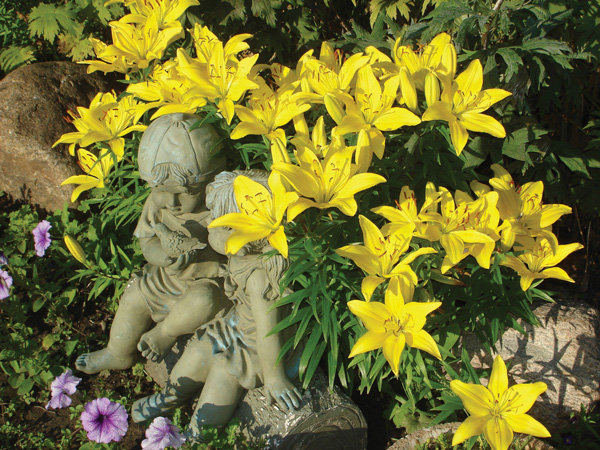HELLO HEAT! Hello July! Hello Independence! Who really wants to be working in the yard when July’s heat explodes upon us? Not this reluctant gardener—that’s for sure! The solu- tion to this problem is making sure to do preliminary work before the heat sets in. “Yardscaping” is not a good task for July, but planning is possible at any time of the year. Look around the garden right now, and observe the plants that seem to be thriving. What kind of area are those in—dry, moist, sunny, shady, etc.? How much care do these plants require? What areas of the yard need sprucing up? Make a mental note, or do a rough drawing to refer back to in September when the tempera- tures cool down. Also, keep an eye out for plant sales, and do some inexpensive experimenta- tion. Remember, anything planted now will need lots of water and lots of mulch!
Think of planting garden favorites that will take care of themselves in the heat of summer. One great choice to fit this bill is the ever popular daylily. These showy creatures have been used in landscaping for many genera- tions. They come in thousands of varieties that give options for size and color of blooms. They are perfect for sunny garden areas where other bloomers wilt and perish. They flower for weeks at a time and make great border plants as well as ground cover to help with erosive conditions. Once established, they require very
little care and adapt to all kinds of weather and temperature conditions. Because daylilies do die back in the winter, a clipping as winter sets in will be required. Mulching helps keep their soil moist, and it should also be well drained. Daylilies do not like to be in swampy spots. The best time to plant or divide them is early spring, but this also can be done when your variety has finished blooming. Dividing should be done only every three to four years. Daylilies look best when they grow in nice thick clumps!
Daylilies grow from a fan-like crown. Their foliage is long, flowing and green. The flowers bloom on the end of a long scape which also comes out of the central crown. Each scape will produce several blooms. The open bloom will only last a day—thus the name daylily! One bloom shuts and another opens. The finished bloom will become a seed pod. These should be removed without going to seed if you want more blooms next year!
Keep this wonderful garden favorite in mind when planning or planting your new and improved “yardscape”! Next July, you will be pleased with your explosion of summer color and the independence a true garden perennial can bring to you!






